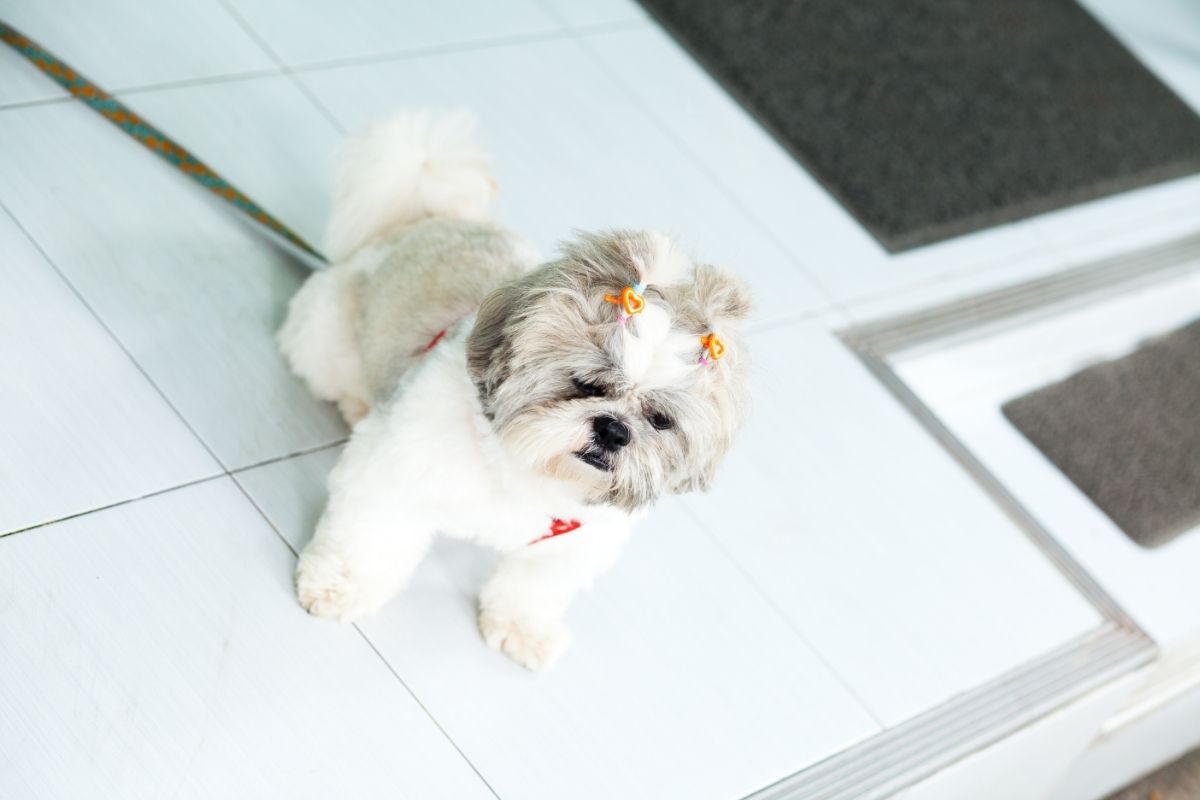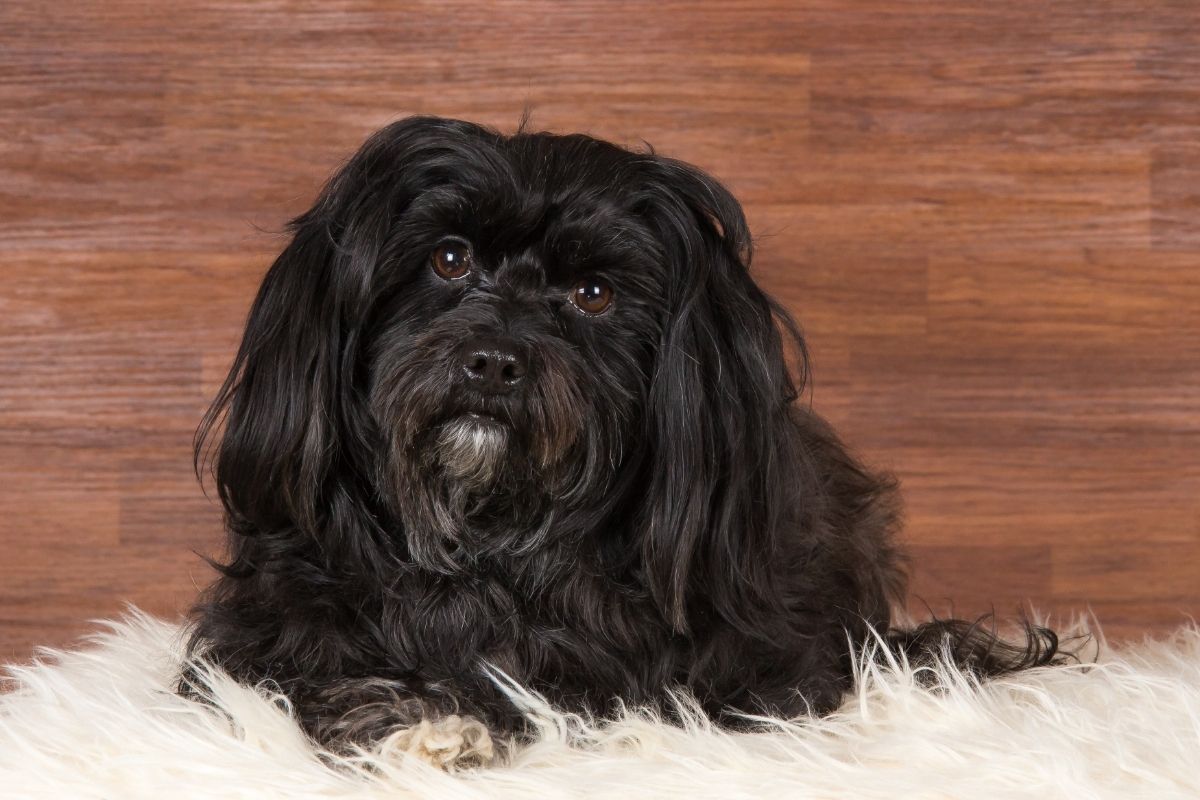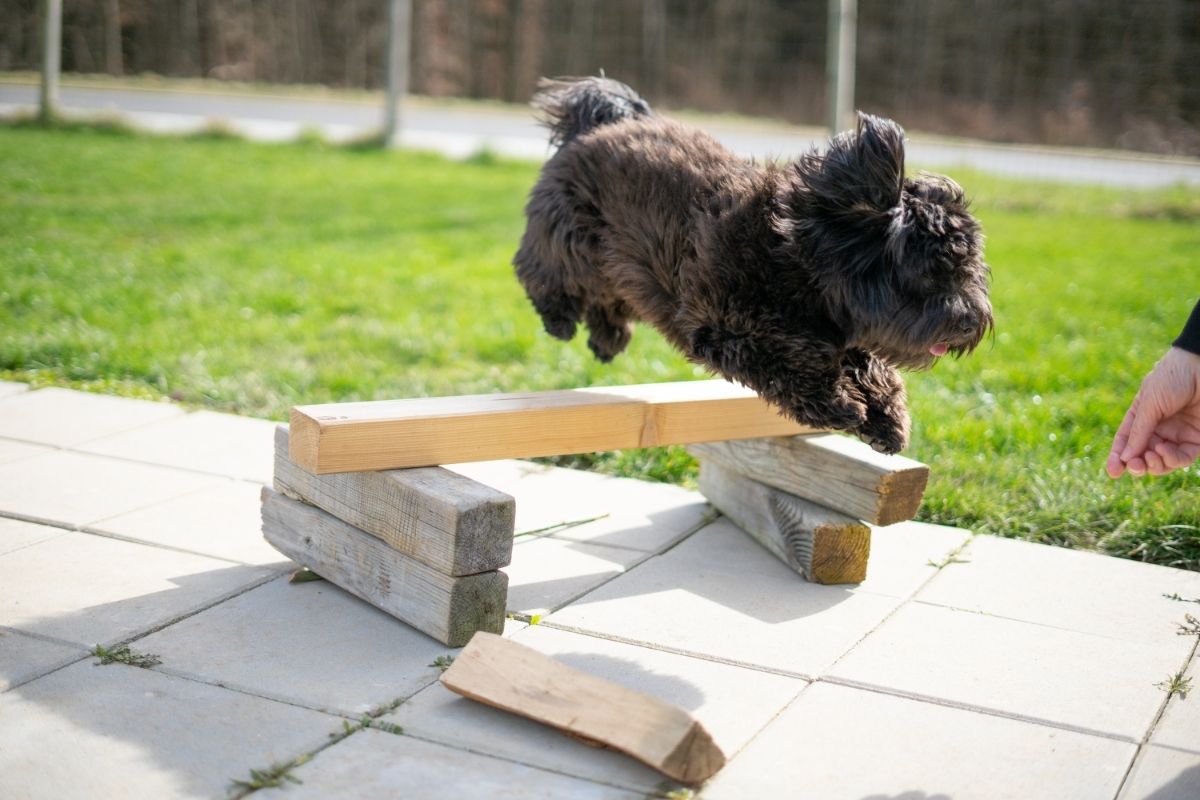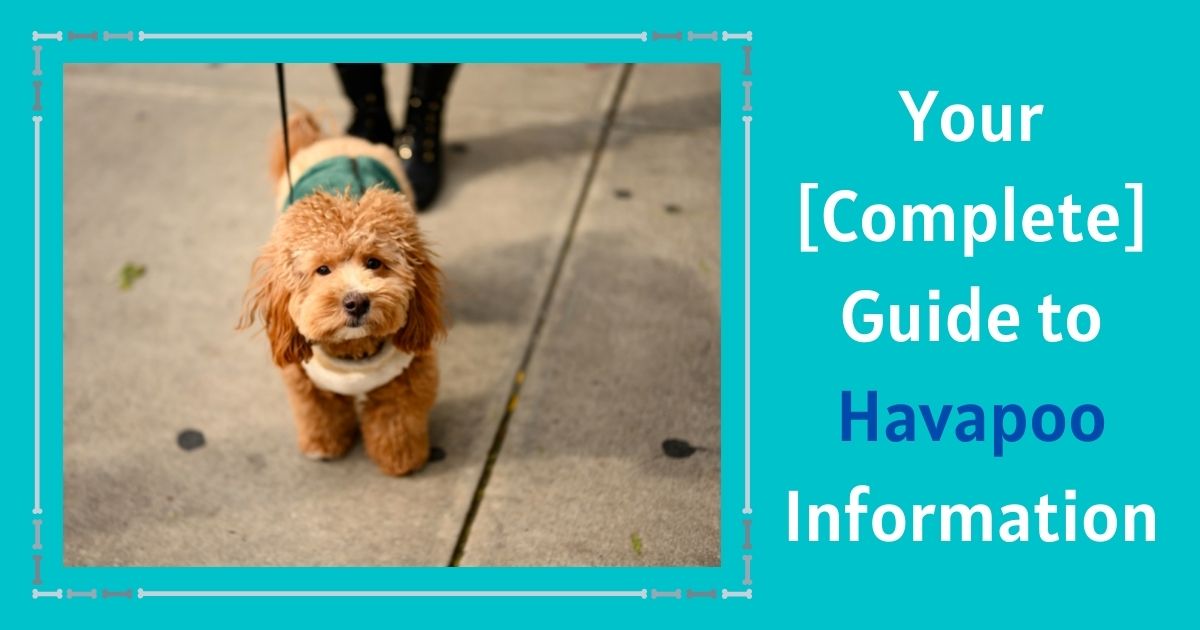What is a Havapoo?
Our complete guide to Havapoos will give you all the Havapoo information you need to consider making this fluffball the newest member of your family. A Havapoo makes for an adorably fluffy and cuddly companion that is a mix between a Havanese and a Poodle (Toy or Miniature).
While the Havapoo is a designer breed and highly sought after, it is not considered purebred, despite both of its parents being purebreds. So if you are looking for a scary-looking guard dog, this will not be the companion for you, but if you want a loyal, friendly, and playful pet for your family, the Havapoo could be the dog for you!

How Much Does a Full-Grown Havapoo Weigh?
The Havapoo is classed as a small, fluffy dog. A full-grown Havapoo is going to weigh between seven to 30 pounds. This makes them the perfect size for an apartment dog and the ideal companion for families with small children.
How Big do Havapoos Get?
The size of your Havapoo will generally depend on the size of their parents (and whether one of the parents is a Toy or Miniature Poodle), so if you want an idea of how big your puppy may grow, you should always go and visit the whole family with the breeder!
A Havanese dog will be pretty standard in size. They weigh between seven to 13 pounds and stand up to 12 inches. The Havanese parent will not be the deciding factor in determining the size of your Havapoo as it is a standard size for most dogs of the breed.
The size of the Poodle parent will be significant in determining your Havapoo’s size as they vary dramatically. A standard Poodle will weigh anywhere between 60-70 pounds and be over 15 inches tall, while the Miniature Poodle will be between 10-15 pounds and 10-15 inches tall. A Toy Poodle will be less than 10 pounds and be up to 11 inches tall.
The size of your Havapoo will depend not only on their genetics but also on their environment and how they were raised as puppies. Generally, you can expect the Havapoo to weigh between seven to 30 pounds and eight to 15 inches tall.
The Havanese dog officially has 16 coat colors, including black and silver, black, faun, and white. The Poodle breed has ten official colors, including blue, black, gray, brown, apricot, and cream, so your Havapoo may end up being a variety or mixture of colors. It is also common for a Havapoo to have white patches on the feet, chest, and face.
Is the Havapoo Hypoallergenic?
For those who want a furry friend to cuddle without the sneezing fits and uncomfortable itching, the Havapoo is an excellent option for you! They have hypoallergenic fur, which means that they shed less and have a coat that is less likely to trigger allergic reactions in people who are sensitive to allergic reactions from dog fur.
Although their fur is generally medium-long in length, they do not shed a lot thanks to their Poodle parent’s genetics, making them hypoallergenic. So depending on their genetics, they will have wavy or curly hair, and it can be medium-length or long.
With a Havapoo, you get all the fun of having a fluffy, cuddly fur-baby without any of the shedding, sneezing, or itching!
When was the First Havapoo Bred?
While it is not known precisely when the Havapoo was first bred, experts suggest that they are a product of the popularity of the Labradoodle (Labrador x Poodle) in the 1980s. When the Labradoodle was introduced, everyone wanted a Doodle cross, and we began to start seeing much more crossbreeding with Poodles.
However, we do have extensive information on the parents of the Havapoo as they are both pedigree breeds. The Poodle originated in Germany over 400 years ago and was initially bred to retrieve waterfowl, although it became increasingly popular with the upper classes for their personalities and aesthetics.
The Havanese breed originated in Cuba (as the name suggests) over 300 years ago and was brought by the Spanish colonists as lapdogs to the nobles. They constantly refined the look to what we see today through selective breeding.
So while the Havapoo may not be considered a pedigree, their parents are both descendants and favorites of the highest class of society! It is no wonder they make such a popular and desirable breed these days.
The Pros and Cons of Owning a Havapoo
Aside from the obvious pro being that they are adorable, we have set up the following table with a few pros and cons to owning a Havapoo.
| Pros | Cons |
| Hypoallergenic. | Prone to hip dysplasia & patella luxation, and some other health concerns. |
| Small breed perfect for apartments/smaller living spaces. | Expensive to buy. |
| Great friendly personalities, get along well with children. | Not suitable as guard dogs. |
| Relatively long lifespan. | Without proper training, it can be nervous/mischievous. |
| Require light to moderate daily exercise. | |
| Fewer health concerns than a purebred dog as they are a mixed breed. |
Health Concerns Associated With the Havapoo Breed
Havapoos may be designer dogs, but they are a mixed breed, which means they will have less chance to inherit genetic disorders than their parent breeds, as their genetics vary. That being said, there are some health issues that the Havapoo is more susceptible to.
The most common issues you may know associated with the Havapoo (generally inherited from their Miniature Poodle parent) are hip dysplasia and patella luxation. These are issues relating to joints and bones. In addition, they may also suffer from Addison’s disease, cataracts, epilepsy, hyperthyroidism, and deafness.
To avoid unwanted high vet bills, it is highly recommended to get insurance for your puppy as soon as you adopt them and educate yourself on how to prevent and/or care for animals prone to these health issues. Below are some examples of the most common health issues associated with the Havapoo and how to notice and hopefully prevent them.
Luxating Patella
Many owners first notice their dog’s luxating patella when it begins limping or non-weight bearing on one of their hind limbs. Unless the limp is wholly unrelated and caused by an injury of some kind, these symptoms in a Havapoo will frequently be caused by a luxating patella.
A luxating patella is defined as the dislocation of the patella (kneecap) from its normal position in the groove of the femur. When the kneecap is dislocated from the groove of the femur, it will only return to the normal position when the dog lengthens the hind limbs and relaxes.
Of course, you should visit a vet as soon as you notice these symptoms and seek professional diagnosis and advice. Still, once you see the signs, you should ideally cage-rest your dog until the veterinary appointment (only taking out for toilet breaks) and always remember to resume exercise gradually after a period of rest.
If your dog is under 12 months, it is not generally recommended to consider reparative surgery, and your veterinarian will advise you on the treatment options suitable for your dog. A healthy diet and proper exercise will help prevent a luxating patella, especially in growing puppies with developing bodies.
We know your puppy loves to run, but too much exercise can sometimes be a bad thing. Over-exercising, especially as a growing puppy, can cause joint issues and lead to painful medical conditions such as a luxating patella. Also, jumping up and down from beds and furniture will cause unnecessary strain on the joints.
It is best to stick to mild-moderate exercise and split up the activity throughout the day, so you are not over-exerting your puppy’s body by doing a large amount of exercise at once.
Cataracts
You have probably seen old dogs that are either blind or going blind with milky, white eyes before. This is the appearance of a cataract growing in the eye lens. Although they generally develop after five years of age, it is not always old dogs that develop cataracts; some Havapoo puppies can be born with cataracts!
The signs can vary depending on the severity of cataracts, and they could appear as white spots in the eyes, opaque or cloudy looking eyes. The lens is located directly behind the pupil and is supposed to be transparent. However, a cataract growth will cause it to become clouded and interfere with the dog’s vision because it keeps the light from reaching the retina.
If the lens becomes completely clouded, it will result in blindness, so you should visit your vet as soon as you notice cataracts developing. Although some dogs may adjust to losing their vision, other severe cases may require surgery to remove cataracts if the cataracts are causing your dog extreme pain. The sight can sometimes be restored through this surgery if diagnosed in the early stages.
The formation of cataracts may be slowed and/or prevented with a good diet and possible supplements. Consult a veterinarian to discuss the best option for your pet.
Heart Disease
Heart failure in dogs will most commonly be caused by a weakened valve (known as mitral valve disease). The valve will become deformed and be unable to close tightly. This can cause blood to leak around the valve and put a strain on the heart. Heart disease is one of the most common causes of death in older Havapoos.
Your veterinarian will most likely notice a heart murmur when they listen with a stethoscope, and they may recommend bloodwork, radiographs, and/or a cardiac ultrasound to diagnose and scope the severity of their heart disease.
When diagnosed early, it can be maintained with consistent yearly diagnostics (this may be bloodwork, radiographs, and/or cardiac ultrasound), medications, and a suitable diet. All these factors can prolong your dog’s life for many years.
Symptoms can include coughing, low energy, and breathlessness. If you notice any of these symptoms, especially in older dogs, it is recommended to take them to your vet for an examination with possible diagnostic tests.
It is essential to keep your dogs weight under control as this has a considerable impact on the health of their heart, especially in later years. A good diet that is not high in fat will also improve heart health when used in conjunction with regular exercise.
Retinal Dysplasia
Another eye disease that the Havapoo is prone to contracting is retinal dysplasia, which can be defined as malformation of the tissue within the retina and abnormal development of the retinal structure. The retinal tissue will be in folds or round clumps and can reduce the vision or, in severe cases, cause blindness to your dog.
This disease does not cause any pain, but you may notice that their quality of life decreases due to low visibility. The symptoms may include changes of color within the eye, excessive tearing of the eye, or behavioral changes (such as clumsiness or inability to navigate efficiently) due to lack of vision.
It is important to note that Havapoos do commonly develop brown tear stains on the fur around their eyes, so any sign of tears may not be a medical condition. The cause of standard tear stains in Havapoos is unknown, but if any other symptoms accompany the tear stains, you should visit the vet to diagnose the issue.
Liver Disease
The Havapoo is more prone to a specific liver disorder known as the Portosystemic Shunt (PSS). This disease is caused when some of the blood going to the liver goes around it instead. Therefore the liver lacks the blood flow it needs to properly function and grow. This will lead to the liver not being able to remove toxins from the bloodstream adequately.
Suppose you start to notice symptoms such as stunted growth, disorientation, poor muscle development, seizures, or circling behavior. In that case, you should visit your vet, who will perform a liver function blood panel. Other diagnostic tests that may be necessary depending on the severity of the symptoms or results of the bloodwork may include an abdominal ultrasound scan of the liver.
In some cases, a prescription veterinary diet may be suitable, and medication, whereas in other situations, they may require surgery. Your veterinarian will make this decision based on the diagnostics, so if you suspect this condition, diagnostics are the first and most crucial step to recovery.
Havapoo Behavior and Temperament
As they are a mix between two breeds, you never know precisely what you will get with a Havapoo! They may favor one side of their genetics in appearance and the other parent’s personality traits.
A Poodle is known to be an intelligent breed that is sensitive to voices and body language. This helps immensely when it comes to training and socializing. They can be wary of strangers or other animals at first, but they are excellent at socializing once they are familiar.
The type of Poodle will also affect their behavior as a Miniature Poodle may be more anxious and excitable than a Standard Poodle. Early socialization and training are helpful when addressing anxiety and excitability in dogs.
A Havanese dog is known for its confidence and playful behavior! However, they can also be mischievous when they feel like they are not getting enough attention.
The Havapoo will be a friendly companion for you and your family and even get along well with other pets in the household (yes, even cats if appropriately introduced!). However, make sure you subject your Havapoo to other pets or children gradually and with positive experiences.
They can bark while excited or playing with another dog but are not generally known to be extremely yappy dogs.
Because of their intelligence and playfulness, they can get bored quickly. Therefore, it is essential to stimulate them mentally and physically. Puzzle feeders and reward-based training will help keep their brains stimulated, and regular exercise is also critical.

How to Take Care of a Havapoo
Diet
As always, it is essential to feed your pets high-quality and nutrient-rich food. If you are unsure which brands are good quality, consult your veterinarian or vet tech for advice. Havapoos should be fed small-breed specific dog food, either kibble or a mixture of kibble and wet food that is nutrient-rich to help fuel their high energy levels.
The amount of food your Havapoo requires each day will depend on the weight, metabolism, age, and/or any health concerns. The food brand will also determine the quantity of the food, and generally, the packaging will have a weight and age-based feeding guideline for you to follow.
Feeding twice a day for adults is recommended to ensure your dog doesn’t overeat in one sitting and gives a more even distribution of energy throughout the day. Puppies will require smaller, more frequent meals throughout the day due to their smaller stomachs.
Grooming
One of the Havapoo’s best qualities is their fluffy, wavy coat, and the maintenance thereof is effortless! Since they do not shed too much, they just require regular brushing of the hair a few times a week to remove the loose hairs and prevent it from getting tangled.
Often owners will over bathe their pets, and it is important to remember that this can strip the hair of its natural oils. However, you can give them occasional baths if they begin to smell or take them to the groomers every few months.
General dog grooming such as teeth brushing, nail trimming, and ear cleaning is also recommended. You will also probably have to clean the eyes of your Havapoo every few days with warm water and cotton wool, as they are prone to developing brown tear stains under the eyes. Do not use soap or other cleaning solutions near the eyes as this can cause damage.
Maintenance
Havapoos are very intelligent thanks to their Poodle parents and can get bored quite quickly. When they get bored, their Havanese parent’s mischievous traits can start to show! So if your Havapoo is acting up and chewing shoes or making a mess, it may be because they are bored and understimulated.
It is crucial to provide them with good exercise and training and to provide them with mental stimulation such as puzzle feeders, chew Toys, kong Toys, and automatic slow feeders. This will help engage them mentally when you are not home and in between walks.
Exercise
Even though they come in a small package, Havapoos still require one or more hours of daily exercise! This is because of their intelligence and that they have high energy levels. Splitting the activity into a morning and evening walk is an excellent way to stimulate them throughout the day. Interaction with other dogs is also essential for socializing and mental stimulation.
Training
Due to their intelligence and eagerness to please their owners, the Havapoo makes the perfect student for training. Positive reinforcement (treats and praise) and strategies will yield the best results in your training sessions.
They are very perceptive in understanding human body language and tone of voice so ensure you are giving plenty of positive reinforcement with your voice and body language.
You will always get the best results from training when it is started at an early age. However, puppy training doesn’t have to begin with training. It starts with socialization from an early age as they learn how to interact with others appropriately.

Does the Havapoo Get Along With Children?
Children adore Havapoos as they tend to look like real-life teddy bears! And they make a great companion for children as they are friendly, playful, and the perfect size for children interaction.
If your Havapoo is more anxious, it is vital to socialize slowly with children and supervise their interactions. In addition, educate your children on proper puppy handling etiquette to make this a positive experience for both your Havapoo and your child.
FAQs on Havapoos
How long does a Havapoo live?
The Havapoo has quite a lengthy lifespan for dogs and can live to 10-15 years of age with good health care, diet, and exercise.
How do I groom my Havapoo?
Grooming your Havapoo is very simple! They just require regular fur brushing every few days and occasional bathing when they smell like they need it. You can also take them to the groomers for a trim as required if you would like, and they can do the nail trimming, ear cleaning, and other grooming tasks you may not be comfortable doing at home.
Can a Havapoo be left alone?
Havapoos can sometimes develop separation anxiety due to to their predisposition to becoming nervous/anxious. Therefore, if you have an anxious dog, it is best to begin training from when they are young.
Do not make a big fuss when you leave the house and return home, so they don’t associate you going as a big deal. Also, provide them with mental stimulation dog toys to entertain them while you are away.
Do Havapoos bark a lot?
Havapoos are not known for being particularly yappy small dogs, and if they are barking excessively, this may be a sign of anxiety/stress which should be addressed and dealt with.
How often will my Havapoo shed?
They do not shed too much as a hypoallergenic breed, which is excellent news for your carpets! Another way to minimize shedding is to regularly brush them to remove any loose hairs and keep their coat in good condition.
Do Havapoos smell bad?
Havapoos as a breed does not generally smell bad. However, this may be different when puppies are messy and not fully toilet trained. If your Havapoo is starting to smell bad, simply bathe them or take them to the groomers.
Do Havapoos get anxious a lot?
Havapoos can develop anxiety due to their high intelligence and inheriting their Toy or Miniature Poodle parent’s nervous tendencies. Adequate training and mental stimulation should help your Havapoo to deal with their anxiety.
The Living Needs of a Havapoo
For a rich and fulfilled lifestyle, the Havapoo will need a loving and affectionate family that can give it plenty of attention and love at home. They also will require mental stimulation through training and mentally stimulating Toys/feeders.
They are fine to live in apartments or smaller houses as long as they go out on regular walks and socialize with other dogs. Overall they are quite a low-maintenance breed and will be happy if you are happy when you are around them!
Fun Facts on the Havapoo
- The Havanese parent was developed from a breed that is now extinct, The Blanquito de la Habana.
- They are also known as Poovaneese or Havnadoodles.
- Their personality can differ dramatically depending on the genetic disposition of their parents.
Key Takeaways
The Havapoo is the perfect fun-loving breed for active families and for socializing with children and other pets! With the proper care and training, they can flourish in any home situation, just be patient and do your preparation and research before adopting this breed.
